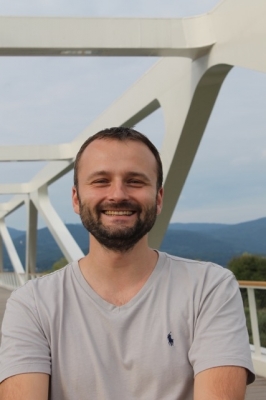Directorio Académico

I am predominantly interested in nuclear/hadronic physics and the study of Quantum Chromodynamics (QCD), the fundamental theory of strong interactions. A project I am particular interested is physics at a future Electron Ion Collider (EIC) which is currently being planned in the US, with possible realizations in Jefferson Laboratory (MEIC) and Brookhaven National Laboratory (eRHIC). The white paper which summarizes key measurements at such a machine can be found at http://arxiv.org/pdf/1212.1701v3.pdf. For more information please check out the wiki pages of the EIC task force at Brookhaven https://wiki.bnl.gov/eic/index.php/Main_Page and Jefferson Lab https://eic.jlab.org/wiki/index.php/Main_Page. Among many other interesting measurements, such an Electron-Ion Collider (the world's first electron-nucleus (eA) collider) will allow to test so-called saturation of the gluon density at small Bjorken x.
The HERA experiment at DESY has been the first to observe the strong rise of the proton structure function at small Bjorken x i.e. a strong rise of the virtual photon-proton cross-section with increasing center of mass energy while the photon virtuality is kept fixed. Within perturvative QCD such a rise translates directly into a rise of the gluon distribution in the proton. While at currently accessible center of mass energies such a rise is well described by perturbative QCD, it is firmly believed that such a rise cannot continue forever. In particular is expected that at some stage the gluon density will become so large such that recombination effects will turn in effect and will lead to a saturation of the gluon distribution. A theory framework which allows for a perturbative QCD description in the presence of large and saturated gluon densities and is then provided by the Color Glass Condesate (CGC). Since the gluon density of a fast moving large nucleus can be strongly enhanced w.r.t the proton, electron-nucleus (eA) collisions provide a convenient setup to test this type of physics at moderate energies. An opportunity at current collider experiments is provided through proton-nucleus (pA) and ultra-peripheral nucleus-nucleus collisions at the Large Hadron Collider (LHC) which allow for a study of saturated nuclei.
A project I am currently working on is the angular correlation of up to 3 observed particles in the presence of saturated gluon densities.
Before joining ICN-UNAM I have been a Research Associate in the Nuclear Physics Theory Group at Brookhaven National Laboratory https://www.bnl.gov/physics/NTG/ and a member of the EIC task force (2012-2014). Before joining BNL, I was a DAAD postdoctoral fellow at the Instituto Física Teórica UAM/CSIC Madrid https://www.ift.uam-csic.es/es (2010-2012). I prepared my PhD thesis at the II. Institute of Theoretical Physics, Hamburg University http://unith.desy.de/ at the DESY campus under the supervision of Prof. Jochen Bartels (2006-2009).
For a complete and up-to-date list of my publications please check inspire HEP http://inspirehep.net/search?ln=en&p=a+hentschinski&of=hb&action_search=Search&sf=earliestdate&so=d

